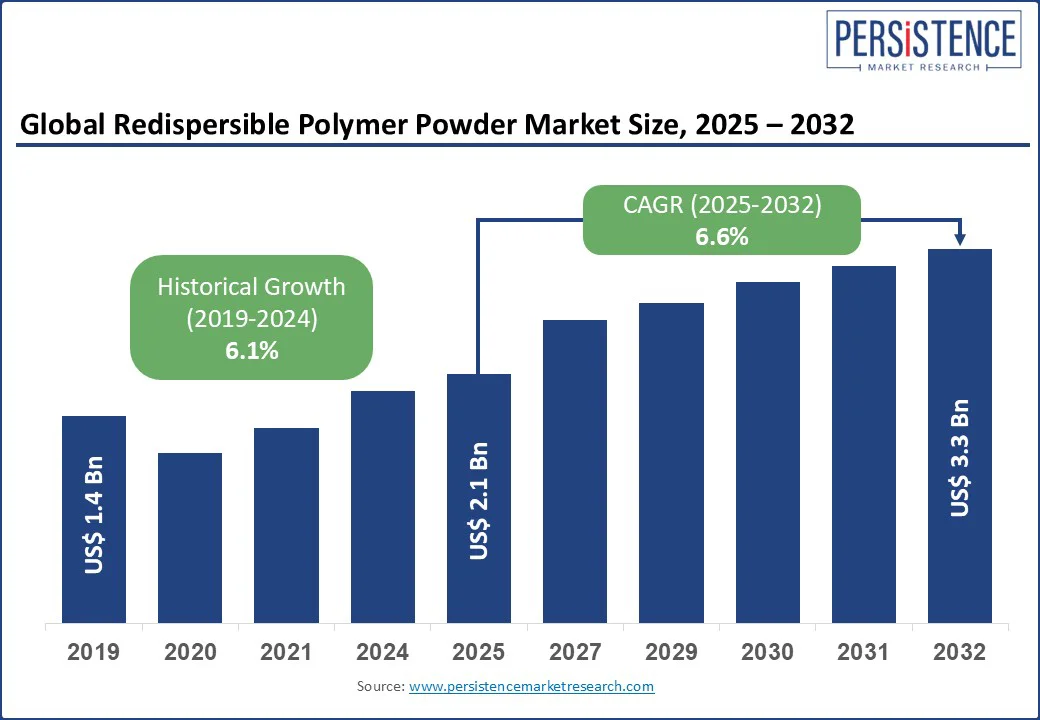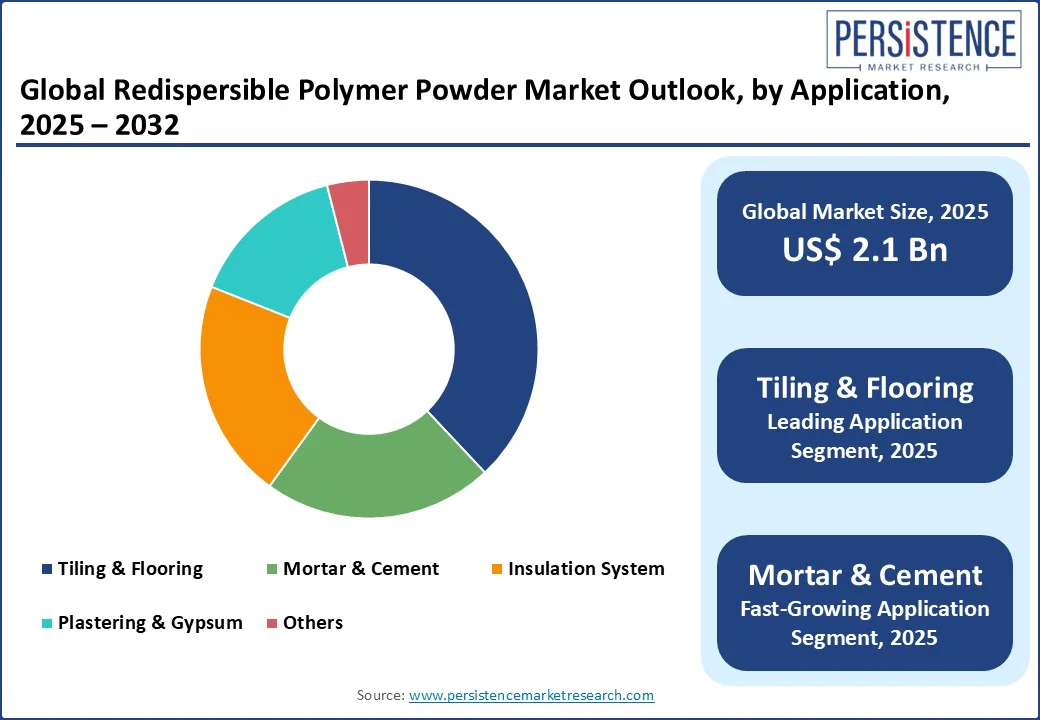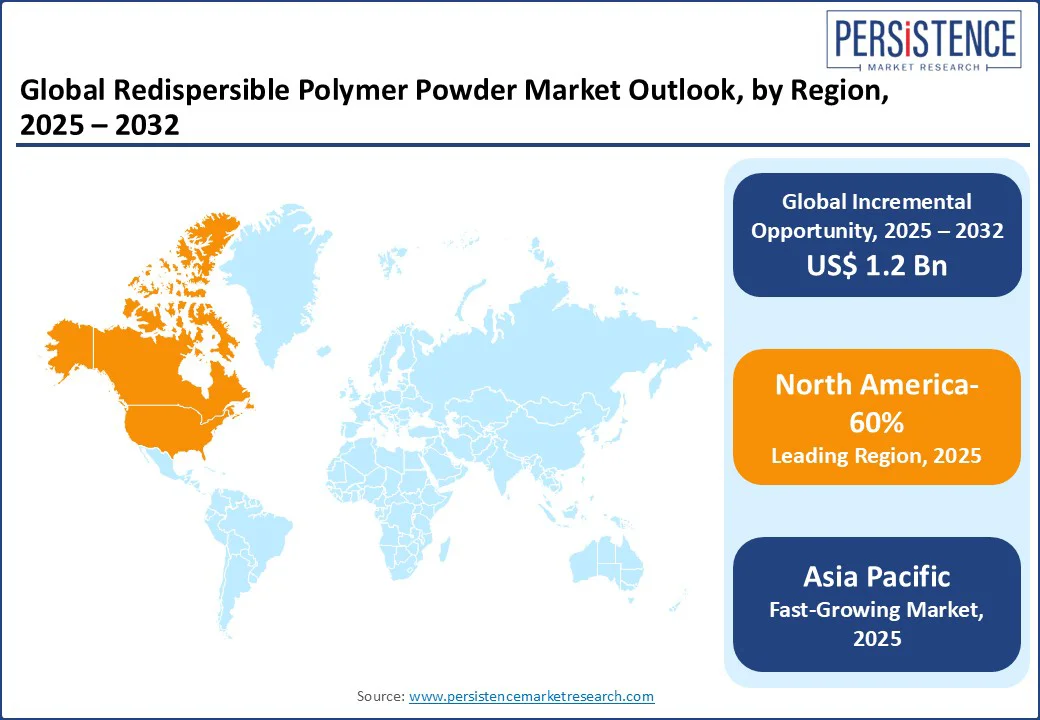ID: PMRREP4374| 198 Pages | 24 Aug 2025 | Format: PDF, Excel, PPT* | Chemicals and Materials

The global redispersible polymer powder (RPP) market size is likely to be valued at US$ 2.1 Bn in 2025, and is expected to reach US$ 3.3 Bn by 2032, growing at a CAGR of 6.6% during the forecast period from 2025 to 2032.
The Redispersible Polymer Powder market is growing rapidly due to increased construction, urbanization, and demand for sustainable, energy-efficient building materials. Technological advancements improve product performance, with Asia Pacific leading growth, supported by infrastructure projects and strict regulations in North America and Europe.
Key Industry Highlights

|
Global Market Attribute |
Key Insights |
|
Redispersible Polymer Powder Market Size (2019) |
US$ 1.4 Bn |
|
Redispersible Polymer Powder Market Size (2025E) |
US$ 2.1 Bn |
|
Market Value Forecast (2032F) |
US$ 3.3 Bn |
|
Projected Growth (CAGR 2025-2032) |
6.6% |
|
Historical Market Growth (CAGR 2019-2024) |
6.1% |
The growing construction industry is a significant driver of the Redispersible Polymer Powder (RDP) market. As urbanization accelerates globally, particularly in emerging economies such as China and India, the demand for modern, durable, and sustainable building materials is rising.
According to the U.S. Census Bureau, construction spending in the United States exceeded $1.9 trillion in 2023, reflecting consistent growth in residential, commercial, and infrastructure sectors. This surge in construction activity increases the need for advanced materials such as RDPs, which improve the adhesion, flexibility, and durability of mortars, adhesives, and coatings.
Furthermore, governments worldwide are emphasizing energy efficiency and sustainability in building projects, further encouraging the adoption of innovative polymer powders that enhance the performance and longevity of construction products.
For instance, India’s Smart Cities Mission is a major government initiative investing over $15 billion to develop 100 sustainable urban centers by 2025. This program focuses on infrastructure modernization, energy-efficient buildings, and improved urban living conditions, which drive the demand for high-quality construction materials, including redispersible polymer powders.
Similarly, the U.S. government’s increased infrastructure spending, as reported by the U.S. Census Bureau, highlights the growing scale of construction projects that require enhanced building materials. These examples demonstrate how government-backed urban development and infrastructure initiatives are directly contributing to the expansion of the RDP market worldwide.
The Redispersible Polymer Powder Market faces challenges from raw material price volatility and supply chain disruptions. In 2025, synthetic polymer prices fluctuated by 15% due to global supply chain issues, increasing production costs for acrylic and VAE powders.
This impacts profitability, particularly in cost-sensitive markets, limiting growth by 10%. The spray-drying process, critical for RPP production, poses risks due to high energy consumption and dust-related hazards, raising operational costs by 12% and deterring smaller manufacturers.
Competition from traditional cement-based solutions and synthetic additives, used in 30% of construction applications, restricts RPP penetration in budget-driven projects.
Stringent environmental regulations, such as VOC emission limits, have increased compliance costs by 10%, challenging small-scale producers. Supply chain disruptions, including a 15% shortage in raw materials such as ethylene, further constrain production, particularly for VAE powders, hindering market expansion in developing regions.
The shift toward sustainable construction and green building certifications presents significant opportunities for the Redispersible Polymer Powder Market. The global green building materials market, projected to grow at a 9% CAGR through 2032, drives demand for eco-friendly RPPs, with low-VOC formulations gaining 20% market share. Innovations in biodegradable RPPs, supported by US$ 5 billion in R&D investments, target applications in insulation systems, growing by 15% in 2025.
The rise of smart cities, with 100 projects planned globally by 2030, increases RPP demand in commercial and institutional end-uses by 18%. E-commerce for construction chemicals, growing at 12%, enhances accessibility for RPP products. Emerging markets, with 2 billion urban consumers by 2030, offer untapped potential, particularly for acrylic powders in high-performance applications. These opportunities position RPPs as a key component in sustainable construction solutions.
The global redispersible polymer powder (RDP) market in 2025 is led by Vinyl Acetate-Ethylene (VAE) emulsions, which hold an estimated 59% market share. Recognized for their cost-efficiency, flexibility, and excellent adhesion, VAE-based powders are widely used in tile adhesives, wall putties, EIFS systems, and self-leveling compounds. Their strong compatibility with cementitious materials and low-VOC profile make them ideal for the growing green construction segment, particularly in Asia Pacific.
Meanwhile, Vinyl Ester of Versatic Acid (VeoVA) is gaining momentum as the fastest-growing RDP polymer type. Despite a smaller market value-estimated at USD 32 million in 2024-VeoVA is increasingly adopted in high-performance construction materials due to its exceptional water resistance, alkali stability, and long-term durability. It is widely used in premium architectural coatings, repair mortars, and specialty renders.
The Redispersible Polymer Powder (RPP) market is largely dominated by its use in the tiling and flooring sector, which holds approximately 38% market share. This strong presence is driven by growing demand for high-performance flooring solutions in residential and commercial construction. RPP enhances tile adhesives by improving adhesion, flexibility, and water resistance, making it essential for modern tiling and flooring applications.
On the other hand, the mortar and cement segment is the fastest growing application in the redispersible polymer powder market. Increasing infrastructure projects and renovation activities worldwide are boosting demand for improved mortar formulations. RPP improves water retention, adhesion, and durability in cement-based products, driving a higher compound annual growth rate (CAGR) in this segment compared to tiling and flooring. This trend highlights the rising importance of RPP in sustainable and resilient construction materials.
The residential sector dominates the Redispersible Polymer Powder (RPP) market, accounting for around 55% market share. The strong demand in residential construction is driven by increasing homebuilding activities and renovation projects, where RPP enhances the performance of tile adhesives, mortars, and flooring materials. Homeowners and builders prefer RPP-based products for their superior durability, flexibility, and water resistance, making them ideal for residential applications.
Conversely, the commercial sector is the fastest growing end-use segment in the redispersible polymer powder market. Growth in commercial infrastructure, including offices, retail spaces, and institutional buildings, is accelerating demand for advanced construction materials. RPP’s ability to improve workability, bonding strength, and longevity of mortars and adhesives is crucial for meeting the rigorous standards of commercial construction, driving its rapid adoption and higher compound annual growth rate (CAGR) compared to the residential sector.

North America leads the Redispersible Polymer Powder (RPP) market with approximately 60% market share, driven by strong construction and renovation activities across the U.S. and Canada. The region’s focus on high-quality, durable, and sustainable building materials fuels demand for RPP in tiling, flooring, mortar, and cement applications.
Advanced infrastructure projects and stringent building regulations further support market growth. Additionally, increasing investments in residential and commercial real estate enhance the adoption of RPP-based products. The North American market remains a key hub for innovation and high-performance polymer powders, maintaining its dominance globally.
Europe holds a notable share of the Redispersible Polymer Powder market, supported by ongoing urbanization and infrastructure modernization across countries such as Germany, France, and the UK. The region’s emphasis on sustainable construction practices and strict environmental regulations encourages the use of eco-friendly polymer powders.
RPP is widely used in flooring, tiling, and mortar applications due to its ability to improve adhesion, flexibility, and durability. Europe’s growing renovation market and investments in commercial and residential sectors contribute to steady growth, positioning it as a key player in the global RPP industry.
The Asia Pacific region is the fastest growing market for Redispersible Polymer Powder (RPP), fueled by rapid urbanization, industrialization, and booming construction activities in countries such as China, India, and Southeast Asia. Increasing demand for affordable and high-performance building materials in residential, commercial, and infrastructure projects is driving growth.
Governments’ focus on infrastructure development and smart city initiatives further accelerates adoption. Rising awareness of RPP benefits such as enhanced workability, water retention, and durability in tile adhesives and mortars makes Asia Pacific a highly promising market with a robust compound annual growth rate (CAGR) .

The global redispersible polymer powder (RPP) market is characterized by technological advancements, product innovation, and increased focus on sustainable construction solutions. Companies are investing in R&D to develop high-performance RPP grades for diverse applications such as tiling, flooring, and mortar.
Market competition is also influenced by regional expansions, capacity upgrades, and partnerships with construction material suppliers. Growing demand in emerging markets, especially in Asia Pacific, is prompting manufacturers to enhance distribution networks and production efficiency to maintain market share.
The redispersible polymer powder market is projected to reach US$ 2.1 Bn in 2025, driven by demand in tiling and insulation systems.
Key drivers include global construction growth, green building trends, and urbanization.
The redispersible polymer powder market is expected to grow at a CAGR of 6.6% from 2025 to 2032, reaching US$ 3.3 Bn.
Opportunities include sustainable RPP formulations, smart city projects, and e-commerce growth.
Leading players include Celanese Corporation, Dow Inc., Wacker Chemie AG, and Synthomer plc.
|
Report Attribute |
Details |
|
Historical Data/Actuals |
2019 - 2024 |
|
Forecast Period |
2025 - 2032 |
|
Market Analysis Units |
Value: US$ Bn, |
|
Geographical Coverage |
|
|
Segmental Coverage |
|
|
Competitive Analysis |
|
|
Report Highlights |
|
|
Customization and Pricing |
Available upon request |
By Polymer Type
By Application
By End-use
By Region
Delivery Timelines
For more information on this report and its delivery timelines please get in touch with our sales team.
About Author